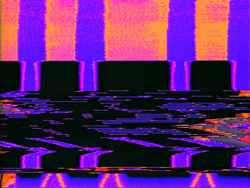LoVid
Biography
Tali Hinkis and Kyle Lapidus began collaborating as LoVid in 2000. An alchemy of independent interests in technology has defined LoVid's aesthetic, combining craft-oriented analog processes and playful engineering with natural and social science. LoVid's live performances, participatory public art works, immersive installations, and video and textile projects express the radiant noise of an electrified but human world.
Inspired by a residency in 2003 at the Experimental Television Center (ETC) in Owego, New York, where LoVid had access to historical image-audio processing devices (including Nam June Paik's "Wobbulator," the Sandin Image Processor, and the Jones Colorizer), the duo began to create their own hand-built synthesizers, culminating in their main instrument, the Sync Armonica, constructed during a residency at Eyebeam in 2005. The reliance on unique, even cumbersome artistic tools is central to LoVid's approach, which deliberately troubles the seamless aesthetics of new consumer technology to focus instead on the relatively crude texture produced by archaic devices.
Tangles of electrical wires and plugs and exposed machinery are primary visual signifiers for LoVid, giving physical shape to the duo's interest in networks and neuroscience, as well as emphasizing the peculiar attenuated process of their instruments. In a 2013 installation, Roots No Shoots, which comprised "visceral compositions" of discarded electronic devices and processed video and audio recorded at ETC in 2011—the last residency hosted by the program—LoVid symbolically connected the function of raw electrical signals with those of social, biological, and environmental systems. For them, "the installation celebrates occurrences when technological chaos takes place with glitches, hacks, and crashes. When we lose control of our devices, we are reminded or our own fragility."
Relating technology to human agency, participation and education are other key aspects of Hinkis and Lapidus's artmaking. In such works as Hack Your Face (2009), Trichrome Navigation (2010), and their ongoing series of site-specific smart-phone Apps, iParade (2010–present), LoVid invites an involving, demystified engagement with electronics that extends beyond the novelty of gadgets to incorporate broader areas of study. In ongoing workshops called Hand Cranked Luminescence, for instance, the duo uses humble materials like recycled fabrics, simple LED lights, wires, and hand-cranks to teach a general audience the basics of electricity, as well as to encourage a discussion on "renewable energy, consumerism, the significance of collaboration, metaphysics, spirituality, and fashion."
LoVid carries forward a legacy that was begun in the early days of video and computer technology in the 1960s and '70s, inspired by individuals and collectives who rebelled against the corporate interests attached to these new media developments. By disrupting the commercial myth of convenience and flawless functioning, LoVid reaffirms technology as a tool in the service of creative and idiosyncratic minds.
Tali Hinkis was born in Israel and studied fine art in the 1990s at the Ecole National Superieure des Beaux-Arts in Paris, and at Cooper Union, New York City. Before working as LoVid, her independent single channel videos and collaborative performances were presented at the Center for Contemporary Art, Tel Aviv; Rencontres Internationales Paris/Berlin; the Knitting Factory, Tonic, and Exit Art, New York City; and many other venues. In 1998, Hinkis co-founded La Superette, an annual art, craft, and music event which ran for eleven years, hosted at venues including La Fleche d?Or, Paris; and Deitch Projects, Participant Inc., and Eyebeam, New York City. Hinkis has extensive experience teaching media literacy in public schools, and has held visiting artist positions at Columbia University, Stevens Institute of Technology, and Stony Brook University.
Kyle Lapidus is an artist and scientist. As an undergraduate at Harvard University, Lapidus studied neurobiology, electronic music, and engineering as part of the "Mind, Brain, and Behavior" focus. Subsequently, Lapidus was involved in experimental music and electronics design, performing in many bands while earning an MD and a PhD in Anatomy and Structural Biology at Albert Einstein College of Medicine. In 1993, Lapidus founded the micro-record label Ignivomous, which released noise music on vinyl and limited-edition cassette tapes and CD-Rs. Ignivomous incorporated as a non-profit in 2007, with a mission of presenting, nurturing, and developing new genres, art forms, mediums and extremes of expression.
LoVid's performances have been presented at the Museum of the Moving Image, Eyebeam, MoMA, PS 1, and The Kitchen; New York City; the Graham Foundation, Chicago; and FACT, UK, among many others. LoVid's videos have been screened in galleries, festivals, and events worldwide including the International Film Festival Rotterdam, Netherlands; Modern Art Oxford, UK; Art in General, New York City; and the Siskel Theater, Chicago. The duo's installations and objects have been included in international solo and group exhibitions hosted by such venues as The Neuberger Museum, the Jewish Museum, New Museum, New York City; Netherlands Media Art Institute, Netherlands; Science Museum Jersusalem, Israel; CAM Raleigh, North Carolina; Real Art Ways, Connecticut; the Science Gallery, Ireland; and Good Children Gallery in New Orleans, where they presented several artist talks. LoVid's large scale interdisciplinary projects, combining new technology with social interventions and public spaces have been supported by and produced in collaboration with Rhizome, Franklin Furnace, Elastic City, free103point9/Wave Farm, The Robert Rauschenberg Foundation. ETC, and the LMCC. LoVid has received additional awards from NYSCA, NYFA, the Foundation for Contemporary Art, and the Greenwall Foundation, and has participated in residences with STEIM, Netherlands; and Harvestworks, Eyebeam, Smack Mellon, and CUE Art Foundation.
